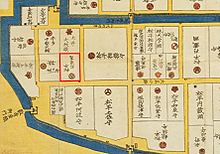Ōkouchi (clan)

Ōkouchi chest in the Ducal Museum Gotha
The Ōkouchi ( Japanese 大 河内 氏 , Ōkouchi-shi ) were a family of the Japanese sword nobility ( Buke ), which was derived from Minamoto no Yorimasa ( Seiwa-Genji ). They later also went by the name of Matsudaira through adoption . Among the branch families, the Ōkouchi with an income of 80,000 koku in Takasaki and the Ōkouchi with 70,000 koku in Yoshida (now Toyohashi ) belonged to the larger Fudai daimyō of the Edo period .
genealogy
Main line
- Akitsuna ( 顕 縄 ; 1179–1230), a grandson of Yorimasa, was the first to take the name Ōkouchi.
- Hidetsuna ( 秀 縄 ; 1546–1618)
- Masatsuna ( 正 縄 ; 1576–1648), Hidetsuna's son, was adopted by Matsudaira Masatsugu, so that her family also had that name.
- Nobutsuna ( 信 縄 ; 1596–1662), Masatsuna's son, was brought up together with the later shogun Tokugawa Iemitsu . In 1633 he got the Oshi-han ( Musashi Province ) with 60,000 koku. In 1638 he replaced the unsuccessful Itakura Shigemasa and ended the Shimabara uprising . Then he was transferred to Kawagoe ( Musashi ) with 90,000 koku. His descendants resided from 1694 in Koga ( Shimousa ), from 1712 in Yoshida ( Mikawa ), from 1729 in Hamamatsu ( Tōtōmi ) and then from 1749 to 1868 again in Yoshida with 70,000 Koku. After 1868 Vice Count.
Secondary lines
-
Nobuoki ( 信 興 ; 1630–1692), fifth son of Nobutsuna, founded a line that started in 1681 in Tsuchiura ( Hitachi ), from 1692 in Mibu ( 壬 生 , Shimotsuke ), from 1695 in Takasaki ( Kōzuke ), from 1710 in Murakami ( Echigo ) and finally resided again in Takasaki with 80,000 koku from 1717 to 1868. This line bore the title 左 京 亮 . The last daimyo was
- Teruna ( 輝 声 ; 1848–1882), after 1868 vice count .
-
Masanobu ( 正 信 ; 1621–1693), son of Masatsuna, founded a line that resided in Ōtaki ( 大多 喜 町 , Kazusa ) with 25,000 koku from 1703 to 1868 . After 1868 Vice Count.
- Masatoshi ( 大 河内 正 敏 ; 1878–1952), son of the last daimyo, was president of the national research institution RIKEN for 25 years .
Individual evidence
- ↑ Furusawa, Tsunetoshi: Kamon daichō . Kin'ensha, n.d., ISBN 4-321-31720-7 , p. 65.
- ↑ Excerpt from the Daimyo koji district map from around 1850.
literature
- Edmond Papinot: Historical and Geographical Dictionary of Japan. Reprint of the 1910 edition. Tuttle, 1972, ISBN 0-8048-0996-8 .
- Miura, Masayuki (Ed.): Shiro to jinya. Tokoku-hen. Gakken, 2006. ISBN 978-4-05-604378-5 .
- Miyaji, Saichiro (Ed.): Bakumatsu shoshu saigo-no hanshu-tachi. Higashinihon-hen. Jinbunsha, 1997. ISBN 978-4-7959-1905-1 .


